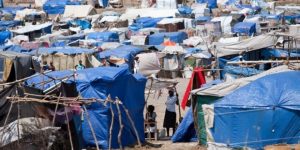Sexual violence in the aftermath of disaster
This blog was written by Abby Cowperthwaite, first-year BSc International Disaster Management and Humanitarian Response student at the Humanitarian and Conflict Response Institute (HCRI). The blog was part of an assessment for the Introduction to Disaster Management module. Abby received one of the highest marks in her cohort, and so we are featuring her blog here. The blog highlights the short and long-term impacts of a disaster toward women in internally displaced persons’ (IDP) camps following the 2010 Haiti Earthquake.
Trigger warning: this blog contains references to sexual violence throughout.
The experiences of women in IDP Camps in the aftermath of the Haiti Earthquake
The Caribbean island of Haiti was hit with a 7.0 magnitude earthquake on 12th January 2010, specifically its capital Port au Prince (de Ville de Goyet et al., 2012), resulting in extensive short and long-term impacts. Gender can determine a person’s vulnerability to the impacts of disasters which presents itself in sexual violence towards women in IDP camps (Duramy, 2012). This blog will explore sexual violence as an impact of long-term displacement to show how disaster exacerbates and highlights gender inequality, with women being left the most vulnerable.
Gender inequality and sexual violence in Haiti
Manifestations of gender inequality resulted in increased sexual violence following the earthquake (Campbell et al. 2016). Social structures that place value on masculinity and associate femininity with weakness perpetuate this inequality (Sheller, 2013) as women’s societal power is reduced, making women more vulnerable to sexual violence. The prolonged impacts of 310,000 homes being destroyed and 1.5 million people having to live in temporary shelters (de Ville de Goyet et al., 2012) has made women particularly vulnerable to sexual violence.
The short-term becoming long-term
Sexual violence increased due to inadequate security and prevention of gender-based violence in IDP camps. This is highlighted by the testimony below.
“My daughter was raped and so I sent her to the provinces. Four men raped her… She is 13 years old…At Place Mausolée, there is no security at all.”
-Guerline, interviewed by Amnesty International (2011).
Camps were overcrowded with a lack of privacy and lighting (Duramy, 2012). Unlike the home, tents are not secure, and a loss of family structure and support meant that women would have felt a constant threat of attack. Police also frequently turned down women who approached them about an incident (Amnesty International, 2011); thus, gender inequality is institutionalised, causing the problem to persist. Further, little treatment was available due to the collapse of hospitals (de Ville de Goyet et al., 2012), and a poor provision of women’s sexual health services (Human Rights Watch, 2011) highlighted the lack of consideration for gendered impacts.
Six years after the earthquake, approximately 62,600 people remained in camps (UN, 2016) as displacement became long-term. With sexual violence continuing and a lack of healthcare, female rape victims would be vulnerable to unwanted pregnancy, sexually transmitted diseases and maternal and infant mortality (Amnesty International, 2011), all of which have long-term consequences. Psychological impacts would likely arise from women’s experiences, such as post-traumatic stress disorder. Rape victims, for example, were found to have suffered from the condition five years after the earthquake (Rahill et al. 2015).
Working towards justice
The International Community and Haitian Government were criticised for ignoring gendered impacts of disaster (Alam et al., 2016). Gender inequality is shown to be institutionalised due to Haiti’s inadequate justice-system. It should be the focus of reforms to prevent violence against women. Grassroots organisations such as The Commission of Women Victims for Victims (KOFAVIV) work with the Haitian Government to reach justice for the women affected (Philips, 2015). Despite this, efforts may be seen as reactive rather than preventative. Policies that prevent violence are therefore needed to dismantle gender inequality and empower women vulnerable to long-term IDP camps and a continuation of sexual violence.
References
Alam, M. et al. (2016) Making Disaster Risk Reduction Policies Inclusive: An Analysis of Humanitarian Aid Organizations in Haiti, Washington D.C, USA: Georgetown Institute for Women, Peace and Security.
Amnesty International (2011) Aftershocks, Women Speak out Against Sexual Violence in Haiti’s Camps, London, UK: Amnesty International.
Campbell, D.W. et al. (2016) ‘Violence and abuse of internally displaced women survivors of the 2010 Haiti earthquake’, Int J Public Health, 61(8), pp. 981-992.
Charles, C. (1995) ‘Gender and Politics in Contemporary Haiti: The Duvalierist State, Transnationalism, and the Emergence of a New Feminism (1980-1990).’ Feminist Studies, 21(1), pp. 135-164.
De Ville de Goyet, C. et al. (2012) Health response to the earthquake in Haiti, Washington D.C, USA: Pan American Health Organisation.
Dermansky, J. (2010) Haiti After the Earthquake. [Online] Available at: https://juliedermansky.photoshelter.com/gallery/After-the-Earthquake/G0000YvIv5uwFRB8/C0000TpzocdTLdeE (Accessed 7th March 2021).
Duramy, B. F. (2012) ‘Women in the Aftermath of the 2010 Haitian Earthquake’, Emory International Law Review, 25, pp. 1193-1215.
Human Rights Watch (2011) Haiti: Earthquake Recovery Failing Women and Girls, [Online]. Available at: https://www.hrw.org/news/2011/08/30/haiti-earthquake-recovery-failing-women-and-girls# (Accessed: 10th March 2021).
Phillips, N. (2015) ‘The Vital Role of Grassroots Movements in Combatting Sexual Violence and Intimate Partner Abuse in Haiti’ in Goel, R. and Goodmark, L. (eds.) Comparative Perspectives on Gender Violence: Lessons From Efforts Worldwide, Oxford, UK: Oxford University Press.
Rahill, G. J. et al. (2015) ‘Symptoms of PTSD in a sample of female victims of sexual violence in post-earthquake Haiti’, Journal of Affective Disorders, 173, pp. 232–238.
Sheller, M. (2013) ‘Sword-Bearing Citizens: Militarism and Manhood in Nineteenth-Century Haiti.’ In Sepinwall, G., A., (ed.) Haitian History: New Perspectives, New York, USA: Routledge.
UN (2016), Haiti Humanitarian Response Plan, January-December 2016 [Online], Available at: https://www.humanitarianresponse.info/sites/www.humanitarianresponse.info/files/documents/files/hti_hrp_060416_final_0.pdf (Accessed 11th March 2021).



0 Comments